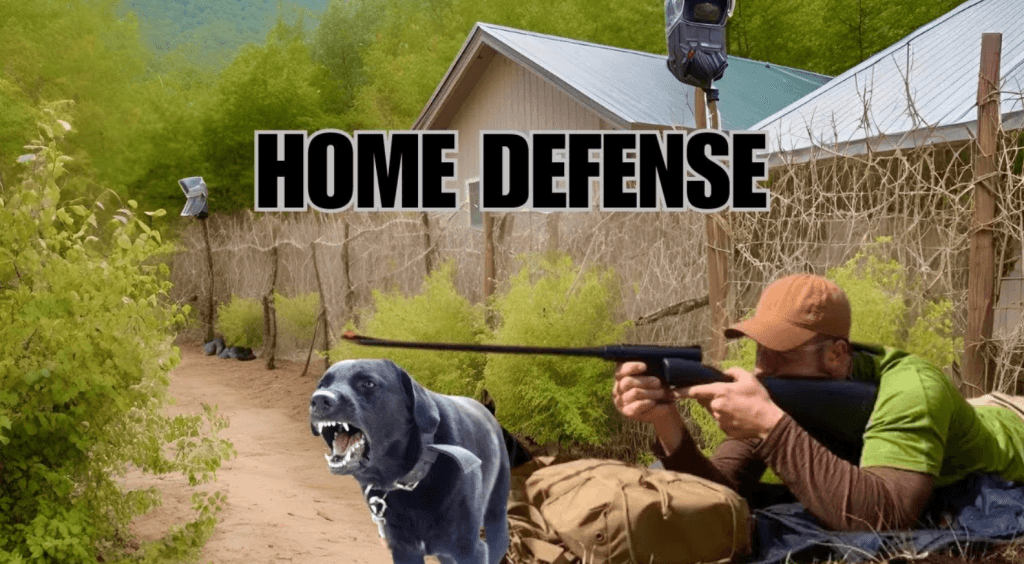
Last week, I was walking my property line at dusk when my ducks suddenly went ballistic. Their frantic quacking echoed across the creek, and I knew something was wrong. As I moved toward the commotion, I spotted a figure crouched near my back fence line, clearly testing my home defense security without knowing I was watching.
That moment reminded me why I take home defense security so seriously. Whether it's a would-be intruder, curious neighbor, or just wildlife, your property needs layers of protection that work together like a well-oiled machine.
After working with Naval Special Warfare as a contractor and countless hours evaluating vulnerabilities on my own land, I've learned that effective home defense security isn't about building a fortress, it's about understanding how bad guys think and staying one step ahead.
According to FBI crime statistics, a burglary occurs every 25.7 seconds in America. That's over 3,300 break-ins every single day. But here's what really gets me fired up: a lot of of these crimes are completely preventable with the right home defense security approach.
I learned this lesson the hard way when I lived in California. We had our car broken into twice in six months, and there were home invasions happening regularly in our neighborhood. This was many years ago, we realized just how close danger could be. Some of the criminals in our town didn’t just pass through. They lived across the street and right next door. One night around 2 a.m., while camping in our small backyard with the kids, we watched the neighbor’s grandkids haul stolen goods straight into their garage. Shame on us for not calling the cops but at the time, I was traveling a lot, and I hated leaving my wife alone around those people. They would have known it was us that called the cops and I didn't know what they would do when I wasn't in town.
One of them, a stocky drug dealer, once stood in our neighbor's yard watching my wife work out and had the nerve to approach her and tell her how hot she was. Back then, I wasn’t as preparedness-minded as I am today, but we did have one clear deterrent: our pit bull, Dudley. We made sure everyone knew he would tear up anyone who came through our door. They tried more than once to win him over, but my wife kept him on the leash and made it clear Dudley wasn’t making friends. They never attempted to break in our home. Just our cars and mailbox.
The stress of constantly looking over your shoulder, wondering if your family is safe. That's no way to live. That's one of the reasons why we don't live there anymore.
The reality is simple: most criminals are looking for easy targets. They want to get in, get what they want, and get out without being seen or caught. Your job is to make your property the least attractive option on the block.
When I assessed my property for a security evaluation, I put myself in a criminal's mindset. If I wanted to break into this house, how would I do it?
I'm not walking straight down the front driveway like an idiot. A really stupid bad guy might, and they're out there, but I want to plan for the worst-case scenario. The really intelligent criminal who's done this before.
Here's my 5-step vulnerability assessment:
Most criminals will come from the back or side of your property, somewhere that's not easily visible from the house or street. That overgrown brush line behind your garage? That might be where they're headed.
The solution isn't complicated: clear the brush, trim back vegetation, and eliminate hiding spots within 50 feet of your house. I know it's work, but what's the worst that can happen if you don't?
Watch my you YouTube video here on SHTF Home Defense: Watch Here
Your first line of home defense security starts at your property boundaries. This is where you want to detect, deter, and delay potential threats before they ever reach your house.
Motion-sensing lights positioned away from your house are absolute game-changers. I'm talking about lights that activate 75-100 feet from your home, not those dinky porch lights that only turn on when someone's already at your door.
The key is placement. Install them along natural approach routes, near gates, and at property corners. When that light pops on, you know something's moved out there, and you can see what's going on.
Pro tip from the field: Get lights with adjustable sensitivity. I've learned this the hard way. Set them too sensitive and every leaf that falls triggers them. Too low, and a person can walk right past. Test and adjust until they're just right.
Motion sensors that chime are phenomenal, but here's the problem I've run into: they can become like the boy who cried wolf. Wind, deer, even my own ducks set them off, and eventually you start ignoring them.
The solution? Zone your detection. Use different tones for different areas, so you know if the alert is coming from your front gate versus your back fence line. This way, you're not running to check every single alert, but you're still maintaining awareness.
Animals make incredible early warning systems. My ducks go absolutely crazy anytime someone approaches the property. Geese and guinea fowl are even better – they're naturally aggressive and will sound off at anything unusual.
Here's something I learned from my tactical training: you want to funnel potential threats into areas where you have the advantage. Use natural barriers like creeks, thick brush, or even planted thorny bushes to guide people toward specific approach routes.
On my property, there's a creek that creates a natural chokepoint. Anyone trying to approach has to either cross at the bridge (where they're exposed) or wade through water (which slows them down and makes noise).
The fence debate: Everyone asks about big fences with razor wire. Yes, they work, but they're expensive as hell. A basic T-post runs about six bucks now, and that adds up fast even on a small property. I prefer strategic barriers that give you the same effect without the massive cost.
During my time working with Navy SEALs, I played the bad guy in training exercises. Let me tell you something that stuck with me: a barricaded person in a secure room is incredibly dangerous to deal with, even for elite warriors. If you know there are threats in your house and you make it to your safe room, it's going to be bad for anyone trying to get in, assuming you've designed it right. My friend's and I went through break in drills with our families. Even my friend's five year old son was deadly with a nerf gun because of the training exercises that we have gone through.
Your safe room doesn't need to be some Hollywood bunker. It needs to be:
The best safe rooms serve multiple purposes. This isn't just for home invasions. Tornadoes, hurricanes, structure fires, or other natural disasters all benefit from having a secure, well-supplied room.
Nothing you own is worth your life or your family's lives. Sometimes the smartest home defense security move is getting out of the house entirely and living to fight another day.
Do you have multiple ways out of every room? Are exits clear of clutter? Do you have escape ladders for second-story windows? These aren't paranoid questions. They're practical planning.
I keep a roll-out ladder hooked to my upstairs windowsill. If there's a fire downstairs and the stairs aren't safe, we're not jumping out a window and breaking legs. We're using the ladder and getting to safety.
Security cameras work, even if they're dummy cameras. Bad guys don't want to be seen or caught, so visible cameras make them think twice about targeting your property.
The key is making them look real. Cheap fake cameras are obvious, but good dummy cameras with blinking lights and proper housing? Criminals can't tell the difference, and they'll probably move on to an easier target. I think real cameras have become much more affordable these days so I highly recommending getting real ones.
Real camera placement strategy:
Don't forget about smartphone integration. Modern systems let you monitor your property from anywhere, get instant alerts, and even communicate with people at your door remotely. I hate the tracking of our personal information that these cameras are collecting but I am not sure which one is worse. I'll leave that up to you to decide.
I believe everyone should have something they can protect themselves and their families with. There are alternatives if you're in areas with restrictions. Everything from bear spray to sharp, pokey things.
Essential gear considerations:
Here's something crucial: if you're using bear spray or similar devices inside confined spaces, you're probably going to be affected too. Plan accordingly and practice in a safe environment so you understand the limitations.
Q: How much should I spend on home defense security? A: Start with free improvements like clearing brush and checking locks, then invest gradually. Motion lights and basic cameras give you the biggest bang for your buck.
Q: Are thorny bushes under windows effective? A: They have pros and cons. While they make window access uncomfortable, they also provide hiding spots. I prefer clear space around the house with barriers further out.
Q: What's the most important home defense security upgrade? A: Consistency. Always lock doors, always check alerts, always maintain your systems. It's the one time you don't that creates vulnerability.
Q: Should I post security system signs? A: Absolutely. Visible deterrents work. Signs saying "Armed Response" or "Video Surveillance" make criminals think twice about targeting your property.
Q: How do I secure an apartment or rental property? A: Focus on door and window security, know all emergency exits, establish family meetup points, and maintain situational awareness. You're more limited but also have fewer vulnerable points.
Q: What about bulletproofing my home? A: Unless you're building from scratch, focus on creating safer areas rather than bulletproofing everything. Concrete planters, safe rooms, and strategic positioning work better than trying to armor entire walls.
Q: How important are guard dogs for home security? A: Any dog that alerts you to threats is valuable. You don't need an attack-trained Belgian Malinois. Even small dogs make excellent alarm systems but I do recommend a protective medium to large size dog.
Here's what separates effective home defense security from security theater: consistency. Always close the gate. Always lock the door. Always check when that motion sensor chimes.
I'm just as guilty as anyone else of getting comfortable. I live in a safe area, so sometimes I let my guard down when I'm at home. But it's exactly because you don't expect something bad to happen that makes you vulnerable.
You don't need to live in constant paranoia, but maintaining some level of situational awareness is crucial. Think of it like the chickens on my property. They don't freak out at every shadow, but they're always aware of what's happening around them.
The criminal is counting on you being lazy, distracted, or forgetful. Don't give them that opportunity.
If you're in an urban environment, your approach needs to be different. Monitor local news and radio traffic. If there are riots, break-ins, and or disturbances on the other side of town, pay attention. You might have time tighten your security measures or pack up and get out before trouble reaches you.
Urban-specific tactics:
Rural properties have different challenges. You've got more space to defend but also more options for defense in depth. Natural barriers, longer approach routes, and fewer neighbors mean you need different strategies than someone in a downtown apartment.
Your home defense security needs change with the seasons. Winter means bare trees provide less concealment but longer hours of darkness. Summer brings thick foliage that creates hiding spots but also longer daylight hours.
Adjust your lighting schedules, trim vegetation seasonally, and modify patrol routes based on changing conditions. What worked in January might need tweaking come July.
The best home defense security includes good relationships with neighbors. Not the nosy kind, but the kind where you watch out for each other. A neighborhood where people pay attention and communicate is a neighborhood that a lot of criminals want to avoid.
Consider starting a neighborhood watch or simple communication network. When everyone's paying attention and sharing information, the entire area becomes less attractive to criminals.
Look, I'm no expert in "home defenseology". That's not a real degree as far as I know. However, I am someone who takes this seriously and constantly looks for weaknesses in my own security setup. The goal isn't to build an impenetrable fortress. It's to make your property enough of a challenge that bad guys move on to easier targets. Layer your defenses, maintain your systems, and stay consistent with your practices.
Remember: the best home defense security system is the one you actually use. Fancy gear sitting in boxes doesn't protect anyone. Simple systems maintained consistently beat complex systems ignored regularly.
What's the worst that can happen if you don't take this seriously? You already know the answer to that question.
So here's my challenge for you: walk your property this week. Look at it through a criminal's eyes. Find three vulnerabilities and make a plan to address them. Start with the free stuff. Clear brush, check locks, establish routines.
Your family's safety is worth the effort. What weaknesses are you going to address first?
Ready to take your preparedness to the next level? Check out my gear recommendations below and subscribe to my Substack and Youtube Channel for weekly tactical insights you won't find anywhere else.
Jason Salyer is a former military contractor who worked alongside Navy SEALs and specialized forces. Based in Georgia, he brings real-world tactical experience to practical preparedness education. As the founder of "On Three," Jason focuses on field-tested survival skills, home defense tactics, and no-nonsense prepper advice. His content has been featured across survival and preparedness communities, and he regularly shares insights gained from years of hands-on experience in challenging environments.
Wazoo Survival Gear https://wazoosurvivalgear.com/?aff=ON3 (Discount code GOON32025)
Bear Forest Knives
Exotac https://www.exotac.com/?ref=7d2vkc2wfx (Discount code On3)
PNW Bushcraft https://www.pnwbushcraft.com/collections/waxed-canvas-bags/products/drawstring-cinch-pack-by-pnwbushcraft
Want more no-nonsense survival and prepper advice?
Let's Go On3...

